The “One Big Beautiful Bill Act,” recently signed into law, has ignited extensive public debate, particularly concerning its far-reaching implications for public health services and social welfare programs across the United States. While initially framed around discussions of federal spending, its profound impact on vulnerable populations and the very fabric of state healthcare systems, especially in rural areas, demands closer scrutiny.
A significant portion of the early discourse surrounding this landmark healthcare legislation centered on its projected effects on critical support systems such as Medicaid and vital food and nutrition initiatives, including the Supplemental Nutrition Assistance Program. Concerns were particularly acute in economically challenged rural states, where these programs form a crucial safety net for countless families and individuals.
The Congressional Budget Office (CBO) provided a sobering forecast on the bill’s health provisions, estimating a substantial reduction in health coverage. Projections suggest that millions of Americans could find themselves without health insurance by 2034, a figure that underscores the profound shift in healthcare access envisioned by the legislation.
Analysts from the Association of State and Territorial Health Officials (ASTHO) further detailed the anticipated state-level repercussions. Their assessment highlighted potential increases in Medicaid coverage loss due to stricter work requirements, altered eligibility criteria, and limits on coverage for non-citizens, alongside a looming challenge for states to meet their share of Medicaid funding amid decreased federal contributions. This creates significant strain on public health initiatives.
Yet, amidst these concerning projections, a pivotal addition emerged from the Senate: the Rural Health Transformation Program. This provision, absent from the initial House-passed version, was strategically inserted to mitigate widespread anxieties that the extensive Medicaid cuts would disproportionately harm the nation’s already beleaguered rural hospitals.
Championed by key Republican senators, the Rural Health Transformation Program establishes a substantial $50 billion fund. This government funding, allocated over five fiscal years from 2026 to 2030, aims to bolster healthcare delivery in underserved rural communities, providing a critical financial injection designed to cushion the impact of federal reductions.
However, an analysis by the Kaiser Family Foundation revealed that while significant, the RHTP’s $50 billion could only offset approximately one-third of the estimated federal Medicaid spending cuts in rural areas. Despite this limitation, the program offers states considerable discretion in how they utilize these funds, providing a vital tool to lessen the overall impact of the broader federal health policy changes.
For states like Mississippi, the legislation presents complex strategic dilemmas regarding their state budgets and the future scope of healthcare services. Lawmakers and state health departments are now tasked with formulating comprehensive programs that align with the bill’s stipulated purposes to maximize the benefits of this new funding for their struggling rural hospital networks.
The National Rural Health Association’s CEO, Alan Morgan, articulated persistent concerns, emphasizing worries over the Senate’s cuts to provider taxes and state-directed payments. He cautioned that despite the Rural Health Transformation Program, its capacity might ultimately prove insufficient to fully address the multifaceted challenges posed by the overarching healthcare legislation.






Leave a Reply